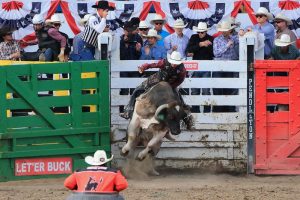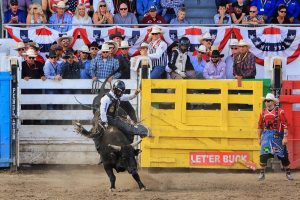1.7 Conclusion
In this chapter, you’ve learned about the sociological perspective and how sociologists use this framework to understand society and human interactions. We can explore seemingly ordinary events, such as the Pendleton Round-Up from a sociological perspective to learn about social institutions and social inequalities. For instance at the beginning of the chapter, we learned how economically important a rodeo can be for communities. While the economy is certainly an important institution, we need to consider how it intersects with healthcare. Given the state of the pandemic, state policies and organizers had to make changes to the Pendleton Round-Up. The Round-Up also offers a site to study representation to understand more about race and gender in this athletic event. Take the image in Figure 1.8. Here we see a man participating in the Brahman Bull Riding event wearing a traditional western hat, rather than a helmet. You can compare this picture with the riders in Figure 1.9 wearing helmets. The unusual choice of selecting a western hat reinforces boundaries of what it means to be “manly” and show power through displays of tough masculinity. You will learn more about gender and constructions of masculinity in Chapter 9. While we’ve explored Pendleton Round-Up from a sociological perspective in this chapter, what other local events could you analyze with your newfound sociological imagination?


1.7.1 Review of Learning Objectives
In this chapter, you learned many core concepts in sociology and how they can apply to the world around you. Sociologists are trained to use their sociological imaginations to examine social life and see things from different perspectives. You may notice that you are able to apply your newly developed sociological imagination when you start evaluating movies, music, and group interactions. Now that you have a sense of what sociology is, it’s time to take a closer look at the different theoretical perspectives sociologists use to make sense of human behavior and identify patterns. The next chapter will explore how sociological theory developed and shapes the perspectives that we use to examine the social world.
1.7.2 Additional Resources
1.7.3 Key Terms
Agency: freewill or the ability to make independent decisions, yet as sociologists we understand that the choices we have available to us are often limited by larger structural constraints.
Diversity: refers to the presence of differences including psychological, physical, and social differences that occur among individuals
Macro level analysis/Macrosociology: study trends among and between institutions and societies. Macrosociology emphasizes the influence of structures, institutions, and systems.
Micro level analysis/microsociology: study small groups and individual interactions. Places a strong emphasis on context, meaning making, and interactions.
Oppression: refers to a combination of prejudice and institutional power that creates a system that regularly and severely discriminates against some groups and benefits other groups.
Privilege: refers to something of value one group has that another group does not, simply by belonging to a group, either as an unearned advantage or an unearned entitlement.
Social facts: the laws, morals, values, religious beliefs, customs, fashions, rituals, and cultural rules that govern social life. These practices exist outside of us as individuals; instead these rules act to constrain our behavior.
Social institutions: large-scale social arrangement that is stable and predictable, created and maintained to serve the needs of society.
Society: refers to a group of people who live in a defined geographic area, who interact with one another, and who share a common culture.
Sociological imagination: an awareness of the relationship between a person’s behavior and experience and the wider culture that shaped the person’s choices and perceptions.
Sociological perspective: a lens that allows you to view society and social structures through multiple perspectives simultaneously
Sociology: scientific and systematic study of groups and group interactions, societies and social interactions, from small and personal groups to very large groups and mass culture. Also the systematic study of human society and interactions.
Structure/social structures: sometimes called social structure, refers to the complex and stable framework of society that influences all individuals or groups through the relationship between institutions (e.g., economy, politics, religion) and social practices (e.g., behaviors, norms, and values). These patterned arrangements both limit and create opportunities for some individuals.
1.7.4 Discussion Questions
- What are some ways individuals can develop their sociological perspective?
- Reflect on the social activities in which you participate. How might you analyze these activities from a sociological perspective to see examples of our social structure?
- Is the experience of discrimination and sundown towns a thing of the past? Check out Road Tripping While Black in Oregon [Blog post] from travel blogger Kay Kingsman to learn more about her experiences “road tripping while black.” What are some ways that policies limit opportunities?
- In what ways have you experienced structure and agency in your own life? What opportunities and limitations were part of that experience?
- Why might someone want to study sociology? What are some ways you would like to see sociology applied in everyday life?
- As you’ve learned in this chapter, sometimes what seems like an individual choice is influenced by larger social and cultural norms. Let’s explore the example of marriage – read this short NPR article The story of marriage equality is more complicated — and costly — than you remember. How are decisions to marry influenced by social acceptability of marriage and marriage equality?
1.7.5 Licenses and Attributions for Conclusion
“Conclusion” by Jennifer Puentes is licensed under CC BY 4.0.
Images
Figure 1.8 Photo by Ian Sane. LET’ER BUCK! License: flickr CC BY-NC-ND 2.0
Figure 1.9 Photo by Ian Sane. To Be Bullish. License: flickr CC BY-NC-ND 2.0
1.7.6 Chapter Bibliography
AP Staff. 2021. “Health officials see COVID cases tied to Pendleton Round-Up.” OPB Retrieved on January 28, 2022. (https://www.opb.org/article/2021/09/28/health-officials-see-covid-cases-tied-to-pendleton-round-up/)
Berger, Peter. 1963. Invitation to sociology: A humanistic perspective. Garden City, N.Y: Doubleday.
Blättel-Mink, Birgit. 2020. “NA Reports – (Public) Sociology in Times of Crisis – The German Experience.” The European Sociologist 1F45). https://www.europeansociologist.org/issue-45-pandemic-impossibilities-vol-1/na-reports-public-sociology-times-crisis-german-experience
Camhi, Tiffany. 2020. “A racist history shows why Oregon is still so white.” Oregon Public Broadcasting Network. Retrieved February 4, 2022. (https://www.opb.org/news/article/oregon-white-history-racist-foundations-black-exclusion-laws/)
Castillo, Elizabeth. 2021. “Pendleton Round-Up will again ‘Let ’er Buck!’” OPB Retrieved on Jan 21, 2022. (https://www.opb.org/article/2021/05/19/think-out-loud-pendleton-round-up/)
Centers for Disease Control [CDC]. 2022. “Health Disparities.” Retrieved February 4, 2022. (https://www.cdc.gov/nchs/nvss/vsrr/covid19/health_disparities.htm)
Centers for Disease Control [CDC]. 2022. “What is Health Equity?” Retrieved February 4, 2022. (https://www.cdc.gov/healthequity/whatis/?CDC_AA_refVal=https%3A%2F%2Fwww.cdc.gov%2Fcoronavirus%2F2019-ncov%2Fcommunity%2Fhealth-equity%2Fracial-ethnic-disparities%2Fdisparities-hospitalization.html)
Collins, Randall. 1981. “On the Microfoundations of Macrosociology.” American Journal of Sociology. 86(5): 984-1014.
CTUIR ICT. 2021. “Board of Trustees Reinstates Public Health Emergency on Umatilla Indian Reservation Due to Spike in COVID Cases.” Retrieved on January 28, 2022. (https://ctuir.org/https://ctuir.org/news/board-of-trustees-reinstates-public-health-emergency-on-umatilla-indian-reservation-due-to-spike-in-covid-cases/)
Department of Sociology, University of Alabama. (n.d.) Is Sociology Right for You? Huntsville: University of Alabama. Retrieved from https://www.uah.edu/ahs/departments/sociology/about.
Durkheim, Émile. 1982. [1st pub. 1895]. Lukes, Steven (ed.). The Rules of Sociological Method and Selected Texts on Sociology and its Method. W. D. Halls (translator). New York: Free Press.
Ferris, Kerry and Jill Stein. 2018. The Real World: An Introduction to Sociology. 6th Ed New York: W.W. Norton & Company
Fonesca, Stan. 2022. “Black Cowboys in Oregon.” Oregon Encyclopedia. Portland, OR: Oregon Historical Society. https://www.oregonencyclopedia.org/articles/black_cowboys_in_oregon/#.YuIh8XbMLIX
Forsyth, Craig J. and Carol Y. Thompson. 2007. “Helpmates of the Rodeo: Fans, Wives, and Groupies.” Journal of Sport and Social Issues 31 (4): 394-416
Fredriksson, Kristine. 1993. American Rodeo, from Buffalo Bill to Big Business. Texas University Press.
Gandy, S. K. 2008. “Legacy of the American West: Indian cowboys, Black cowboys, and vaqueros.” Social Education, 72(4): 189-194.
Garretón, Manuel Antonio. 2005. Social sciences and society in Chile: institutionalization, breakdown and rebirth. Social Science Information, 44(2-3), 359–409. https://doi.org/10.1177/0539018405053292 and http://200.6.99.248/~bru487cl/files/MAG.pdf
Hagar, Shelia. 2021. “State of emergency declared again in Umatilla County, Round-Up will still let ‘er buck.” Union-Bulletin.com. Retrieved on Jan 21 2022. (https://www.union-bulletin.com/news/health_fitness/coronavirus/state-of-emergency-declared-again-in-umatilla-county-round-up-will-still-let-er-buck/article_6ca7d1ee-fb15-11eb-9656-675d31f7c83c.html)
Ishchenko, Volodymyr. n.d. “A Russian Invasion of Ukraine Could Destabilize Russia’s Political Order.” Truthout. Retrieved April 21, 2022 (https://truthout.org/articles/a-russian-invasion-of-ukraine-could-destabilize-russias-political-order/).
Kurtzleben, Danielle. 2021. “The story of marriage equality is more complicated — and costly — than you remember.” NPR https://www.npr.org/2021/12/31/1068894397/the-story-of-marriage-equality-is-more-complicated-and-costly-than-you-remember Retrieved on Feb 6, 2022.
Loewen, James W. 2005. Sundown Towns: A Hidden Dimension of American Racism.
McGrane, Bernard. 1994. The Un-TV and the 10 MPH Car: Experiments in Personal Freedom and Everyday Life. New York: Small Press.
Mellis, Allison F. 2003. Riding buffaloes and broncos: Rodeo and Native traditions in the Northern Great Plains. Norman: University of Oklahoma Press.
Mills, C. Wright. 1959. Sociological Imagination. New York: Oxford University Press
Patton, Tracey Owens and Sally M Schedlock. 2012. Gender, Whiteness, and Power in Rodeo: Breaking Away from the Ties of Sexism and Racism. Rowman & Littlefield.
Pendleton Round-Up. n.d. “History.” Accessed February 18, 2022. https://www.pendletonroundup.com/p/round-up/147.
Schwalbe, Michael. 1998. The Sociologically Examined Life: Pieces of the Conversation. Mountainview: Mayfield Publishing Co.
Suzuki, Shunryu. 1970. Zen Mind, Beginner’s Mind. Weatherhill: New York.
UNAIDS Fact Sheet. World Aids Day- 2021 (2021). https://www.unaids.org/sites/default/files/media_asset/UNAIDS_FactSheet_en.pdf
Willingham, William F. 2021. “Pendleton Round-Up.” Oregon Encyclopedia, Oregon Historical Society. https://www.oregonencyclopedia.org/articles/pendleton_round_up/#.Yg_5KO7MJhF.
World Health Organization (WHO). (n.d.). “About Behavioural and cultural insights for health.” Www.euro.who.int. https://www.euro.who.int/en/health-topics/health-determinants/behavioural-and-cultural-insights-for-health/about-behavioural-and-cultural-insights-for-health
